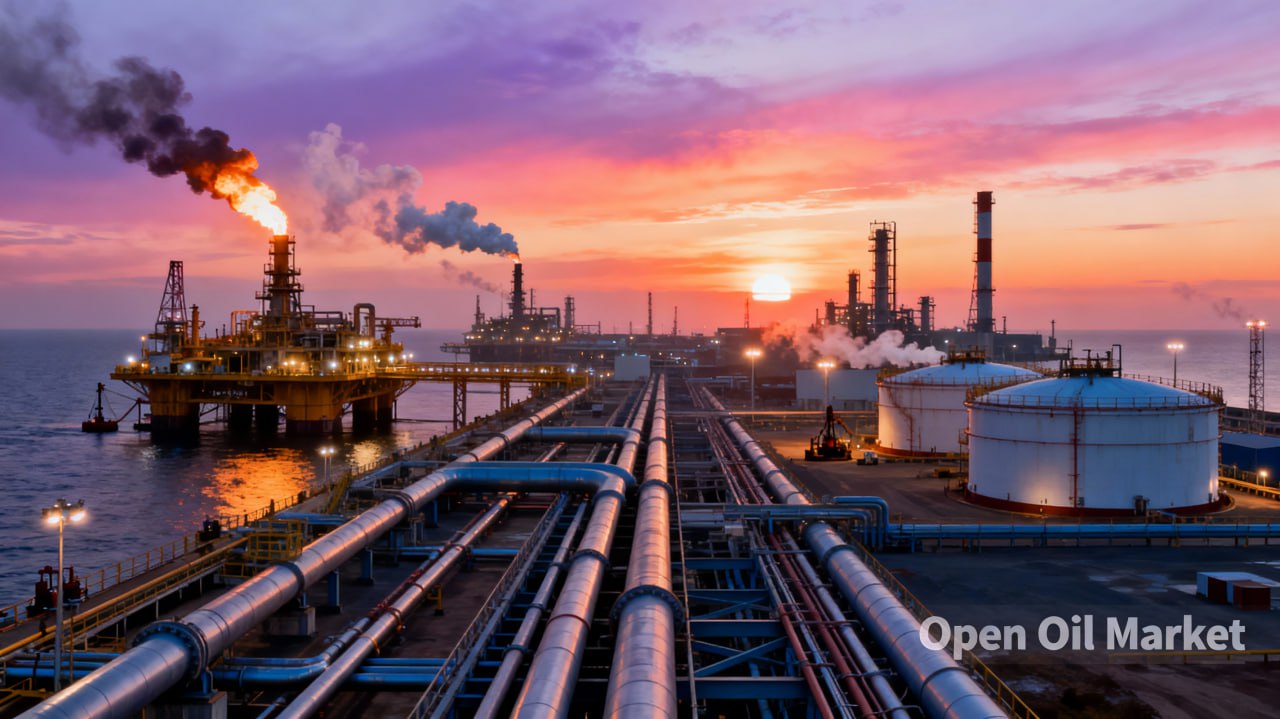
Energy Sector News, Friday, July 25, 2025: Brent Below $70, Record Gas Reserves, Gasoline Export Ban from August
This issue of the fuel and energy sector review covers key events and trends as of July 25, 2025. The global oil market shows price stability, with Brent oil continuing to trade below the $70 per barrel mark. Gas storage in Europe is being filled at record rates, reducing risks for the upcoming winter season. In the domestic market of Russia, decisive measures are being discussed to stabilize prices for oil products, including a complete ban on gasoline exports starting August 1. We will also look into the situation in the coal industry, developments in renewable energy sources (RES), electricity generation statistics, and some geopolitical aspects of energy trading. This information will be useful for investors and market participants, ranging from oil and fuel companies to electricity and coal industry specialists.
Oil Market: Stable Prices Amid Rising Production
Oil companies in OPEC+ countries are gradually increasing production in line with the easing of restrictions. According to the International Energy Agency (IEA), oil production in Russia increased by 20,000 barrels per day in June 2025, reaching 9.19 million barrels per day. This figure exceeded Russia's OPEC+ quota (9.05 million barrels per day) by approximately 140,000 barrels. Similar quota breaches were observed in June among several other major producers, including Saudi Arabia, Iraq, the UAE, and Kuwait. Meanwhile, some participants in the agreement (such as Azerbaijan and Nigeria) did not reach their limits. Since April 2025, the OPEC+ alliance has been increasing the total production limit monthly (by 411,000 barrels per day from April to July), and quotas will be raised by 548,000 barrels per day starting in August. These measures aim to ease previous restrictions and saturate the market with additional crude oil volumes.
Oil production in Russia reached 9.19 million barrels per day in June, exceeding the OPEC+ quota by 140,000 barrels per day. The increase in OPEC+ quotas, coupled with risks of a slowdown in the global economy, has led to a cooling of the oil market: Brent prices remain firmly below $70 per barrel.
Indeed, Brent quotes remain within a narrow range below the psychological level of $70 this week. As of Friday morning, prices fluctuate around $69 per barrel. Investors are closely monitoring the balance of supply and demand: on one hand, increased supply from OPEC+ and exporters puts downward pressure on prices; on the other hand, concerns about the state of the global economy and demand for energy resources also prevent oil quotes from rising. Meanwhile, data from the US regarding a reduction in oil inventories and news about potential monetary policy easing support the market, preventing prices from falling significantly below current levels. As a result, by the end of the week, the oil market maintains relative stability, close to levels seen at the end of June.
Gas Market: Record Reserves and Stable Prices
The European gas market is demonstrating strong filling of storage facilities ahead of the upcoming heating season. According to data from Gas Infrastructure Europe, underground gas storage (UGS) in EU countries is over 65% full—this high level for July is a record in recent years. In absolute terms, gas inventories have already exceeded 70 billion cubic meters by mid-month. In comparison, a year ago, significantly less fuel had been accumulated by this date. The rate of injections has also been record-breaking: in June, Europeans injected approximately 12.4 billion cubic meters of gas into storage, representing the highest monthly volume in the last three years. Contributing factors to this surge include a relatively mild winter and reduced consumption, as well as increased imports of liquefied natural gas (LNG)—around 12 billion cubic meters of LNG arrived in Europe in June, marking a record figure for the first summer month.
High gas reserves allow Europe to feel more secure: despite the reduction of pipeline supplies from Russia, EU countries are compensating with record volumes of LNG from the US, Qatar, and other exporters. Gas prices at the European TTF hub in the summer of 2025 remain relatively stable—significantly below the peak values of 2022. However, they remain above long-term average levels: according to IEA estimates, wholesale gas prices in Europe will stay above $400 per 1,000 cubic meters in 2025–2026 due to structural market factors. Investors and the industry, in general, welcome the accumulation of reserves as it reduces the risks of sharp price surges in winter. However, market participants continue to monitor potential EU decisions regarding further reductions in dependency on Russian gas. Against the backdrop of discussions on new sanctions against Russia, Hungary has already stated that it will seek separate solutions with Russia in the event of a European-wide ban on Russian gas imports—this signal underscores the ongoing divisions within the EU regarding energy security.
Fuel Market in Russia: Gasoline Export Ban and Stabilization Measures
Significant changes are brewing in the Russian fuel market. In recent weeks, there has been a rise in exchange prices for automotive gasoline and diesel, creating tension for consumers and the market. The reasons include seasonal factors (increased summer demand, particularly for agricultural fuel and lubricants) and reduced supply due to planned repairs at oil refineries (OR). Many refining companies have taken capacities offline for maintenance in June and July, temporarily reducing gasoline and diesel production. As a result, wholesale prices on the St. Petersburg International Mercantile Exchange approached a threshold level, at which oil companies stop receiving damping subsidies—this situation alarmed the market and authorities.
The authorities and fuel companies are developing a set of measures to stabilize the situation in the oil products market. Key steps being discussed and partially implemented include:
- Complete export ban on gasoline for all producers—media reports that relevant authorities are preparing a decision to introduce an embargo starting August 1, 2025, for a duration of one to two months. This measure aims to saturate the domestic market and halt the increase in prices for motor fuel.
- Extension and expansion of existing limitations—a temporary restriction on gasoline exports was previously introduced until August 31 (for independent traders who are not producers). Now, consideration is being given to extending the ban to include the oil companies for the specified period.
- Smoothing exchange volatility—the Ministry of Energy of the Russian Federation, along with the Federal Antimonopoly Service and St. Petersburg Exchange, are developing measures to reduce speculative price fluctuations. Changes to trading mechanisms and minimum fuel sales standards are being discussed to prevent market participants from creating artificial shortages.
- Coordination of refinery repairs—the relevant authority is “manually” monitoring maintenance schedules at oil refineries. The goal is to avoid situations where too many capacities are offline simultaneously and to ensure even distribution of repairs without compromising fuel supply.
- Increasing exchange shipments—oil companies are instructed by the government to increase the volumes of gasoline and diesel sold through exchange trading, directing additional batches from reserves and through temporary reductions in export shipments into the market. This should enhance competition and lower wholesale prices.
It is expected that the combination of these measures will stabilize prices at gas stations and prevent fuel shortages during peak demand periods. The market is closely watching the official announcement regarding the export ban—investors are assessing the potential impact of restrictions on the revenues of oil companies, while agrarians and transporters are hoping for a prompt reduction in gasoline and diesel prices domestically. The government, in turn, signals that it will not allow a fuel crisis: additional tools, such as subsidizing fuel transportation to remote regions or temporarily reducing excise taxes, may be activated if necessary.
Coal Industry: Record Production and Controlled Demand
The global coal sector continues to remain at historic highs in production volumes, although the growth rate of demand is slowing down. According to the latest IEA forecast, global coal production in 2025 may increase slightly to around 9.2 billion tons, setting a new record. The main contribution to this growth will come from China, where domestic coal production is expanding to support the energy sector. However, global coal demand is expected to grow by just 0.2% this year, and a slight decline is anticipated in 2026. Essentially, consumption has approached a “peak plateau,” reflecting the accelerated transition of many countries to cleaner energy sources.
For Russia, the coal industry in 2025 presents a mixed outlook. On one hand, according to Rosstat, coal production in Russia increased by 1.6% year-on-year in the first half of the year. The industry has managed to redirect export flows to new markets: for instance, supplies of Russian coal to "friendly" countries (Asia, the Middle East, Africa) increased by about 5% from January to May. This has partially offset the decline in exports to Europe due to sanctions. On the other hand, global prices for thermal coal remain relatively low compared to last year, impacting the revenues of Russian coal producers. Many mining companies are facing profit pressures and optimizing costs. Nevertheless, the government declares support for the sector: projects are being implemented to develop port infrastructure in the Far East and subsidize coal transportation by rail to boost exports to the Asia-Pacific region. In the long run, considering the global trend towards reduced carbon emissions, coal energy in Russia will also strive for modernization and increased environmental sustainability, despite the continued significant role of coal in the energy balance.
Renewable Energy: Capacity Growth and Environmental Impact
Renewable energy sources (RES) continue to gain momentum both globally and in Russia. According to data from the Association for the Development of Renewable Energy (ARVE), over the past year, Russian solar and wind power plants have managed to prevent around 8 million tons of CO2 emissions into the atmosphere. This indicates a gradual “greening” of the energy sector: although the share of generation based on RES remains relatively small in the overall balance (only a few percent in Russia), it is rapidly growing. In 2025, new wind farms and solar stations have been commissioned, especially in southern regions and the Far East, along with pilot projects utilizing energy from small hydropower plants and biofuels.
Global trends are also demonstrating record rates of growth in “green” energy. China remains the largest investor in this area: in the first five months of 2025, China installed approximately 46 GW of new wind turbines and around 200 GW of solar capacity—an unprecedented scale reflecting Beijing's drive to accelerate the electrification of its economy. This leap has resulted in more than 90% of all new energy capacities brought online in China this year being from clean sources. At the same time, China continues to build modern coal-fired power plants to provide base load, yet the share of coal in generation is gradually decreasing. In Western countries, renewable energy has already displaced coal generation: the variable nature of solar and wind output is compensated by gas capacities and energy storage systems. All of this indicates a global turning point: investments are shifting towards RES, and carbon-intensive sectors must adapt. For energy sector investors, this trend presents new opportunities—from developing projects in solar and wind energy to modernizing networks and energy storage solutions.
Power Sector: Decrease in Output and Tariff Changes
In the electricity sector of Russia, production showed a slight decline in the first half of 2025. According to Rosstat, the total electricity generation for the six months amounted to approximately 600 billion kWh, which is 1.9% less than the previous year. The decline is primarily associated with reduced generation at hydropower plants—due to a less water-rich year, hydropower output fell nearly 12% (to 98 billion kWh for the half-year). Thermal power plants partially compensated for this, increasing their electricity generation by 0.5% (to 394 billion kWh), while nuclear power plants showed a relatively stable result (104 billion kWh, -0.3% year on year). As such, the structure of generation has shifted somewhat towards thermal energy and nuclear plants, while hydroelectric energy has reduced its contribution due to natural factors.
Another significant event for the sector was tariff changes: starting July 1, 2025, Russia has implemented a planned adjustment of electricity prices for the population and businesses. Housing and utility tariffs, including electricity, have increased by an average of 11-12% across the country. This annual increase, stipulated by the government, is intended to help energy companies cover inflationary costs and invest in infrastructure. However, the increase in tariffs inevitably raises the burden on industry and households. In response, authorities have announced targeted support programs for low-income categories impacted by rising payments and noted that further increases in the coming years will follow a decreasing trajectory (for example, around 9% in July 2026). For investors in the power sector, the tariff hikes mean potential revenue growth for energy supply and generation companies, although the government is keenly monitoring to ensure that tariff policy does not accelerate inflation or hinder economic growth.
Geopolitics and Energy Trade: Reconfiguring Flows
Global energy resource trading is undergoing changes influenced by geopolitical factors. In particular, market participants have drawn attention to news about a sharp decrease in energy imports between the US and China. According to Bloomberg, in June 2025, China did not purchase any oil, liquefied natural gas (LNG), or coal from the United States for the first time in nearly three years. Experts attribute this to growing tensions in trade relations between the two countries and China’s desire to diversify its supply sources. Beijing is increasing oil purchases from Middle Eastern and African countries and expanding imports of Russian raw materials, taking advantage of price discounts. Similarly, significant volumes of LNG are arriving from Qatar, Australia, and through the spot market, bypassing American gas.
At the same time, Europe continues to reduce its energy dependence on Russia. Imports of Russian oil and petroleum products into the EU are under embargo, and gas supplies have been reduced to minimal levels. The European Union is actively developing infrastructure to accept LNG and is seeking new long-term contracts with alternate gas suppliers. However, a complete rejection of Russian gas has not yet been realized—some countries, such as Hungary, maintain high levels of purchases under contracts with Gazprom. Statements from Hungarian leadership about their readiness to negotiate with Moscow bypassing Brussels (in the event of an EU-wide ban on Russian gas) demonstrate the limitations of a unified position within the bloc. Overall, geopolitical risks remain one of the main drivers of the reconfiguration of global energy trade routes. While the current market conditions—prices for oil, gas, and coal—are primarily determined by fundamental factors of supply and demand, political decisions can significantly impact the availability of certain energy carriers for individual regions.
In conclusion, the energy sectors have reached the midpoint of summer 2025 in a state of relative balance, but with clear signals of forthcoming changes. The oil market remains stable due to coordinated actions of producers, although it remains sensitive to economic risks. The gas market in Europe is entering the next winter with record reserves, alleviating investor concerns. The domestic fuel segment in Russia is at a tipping point: the introduction of export restrictions and other measures should normalize gasoline prices. The coal sector continues to operate under shifting demand and heightened environmental agendas. Renewable energy and the power sector demonstrate trends of growth and structural changes, from tariffs to new technologies. Geopolitics continues to weave into the fabric of energy markets, forcing companies and states to flexibly redirect resource flows. Participants in the energy sector—from investors to industrial giants—are taking these factors into account in their strategies, awaiting further developments in the second half of the year.





